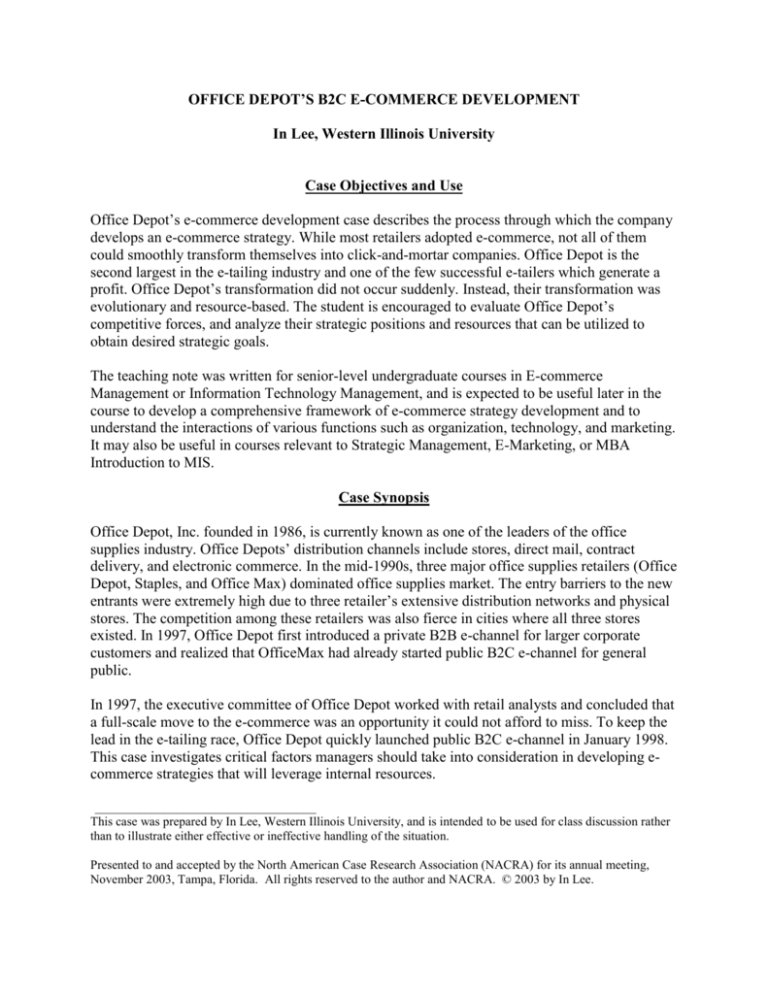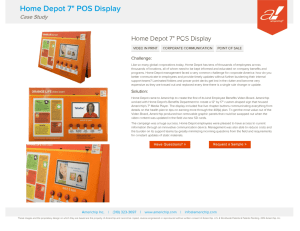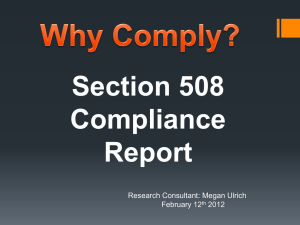
OFFICE DEPOT’S B2C E-COMMERCE DEVELOPMENT
In Lee, Western Illinois University
Case Objectives and Use
Office Depot’s e-commerce development case describes the process through which the company
develops an e-commerce strategy. While most retailers adopted e-commerce, not all of them
could smoothly transform themselves into click-and-mortar companies. Office Depot is the
second largest in the e-tailing industry and one of the few successful e-tailers which generate a
profit. Office Depot’s transformation did not occur suddenly. Instead, their transformation was
evolutionary and resource-based. The student is encouraged to evaluate Office Depot’s
competitive forces, and analyze their strategic positions and resources that can be utilized to
obtain desired strategic goals.
The teaching note was written for senior-level undergraduate courses in E-commerce
Management or Information Technology Management, and is expected to be useful later in the
course to develop a comprehensive framework of e-commerce strategy development and to
understand the interactions of various functions such as organization, technology, and marketing.
It may also be useful in courses relevant to Strategic Management, E-Marketing, or MBA
Introduction to MIS.
Case Synopsis
Office Depot, Inc. founded in 1986, is currently known as one of the leaders of the office
supplies industry. Office Depots’ distribution channels include stores, direct mail, contract
delivery, and electronic commerce. In the mid-1990s, three major office supplies retailers (Office
Depot, Staples, and Office Max) dominated office supplies market. The entry barriers to the new
entrants were extremely high due to three retailer’s extensive distribution networks and physical
stores. The competition among these retailers was also fierce in cities where all three stores
existed. In 1997, Office Depot first introduced a private B2B e-channel for larger corporate
customers and realized that OfficeMax had already started public B2C e-channel for general
public.
In 1997, the executive committee of Office Depot worked with retail analysts and concluded that
a full-scale move to the e-commerce was an opportunity it could not afford to miss. To keep the
lead in the e-tailing race, Office Depot quickly launched public B2C e-channel in January 1998.
This case investigates critical factors managers should take into consideration in developing ecommerce strategies that will leverage internal resources.
___________________________________
This case was prepared by In Lee, Western Illinois University, and is intended to be used for class discussion rather
than to illustrate either effective or ineffective handling of the situation.
Presented to and accepted by the North American Case Research Association (NACRA) for its annual meeting,
November 2003, Tampa, Florida. All rights reserved to the author and NACRA. © 2003 by In Lee.
PortIC : THE ELECTRONIC TRADING INFRASTRUCTURE
AT THE PORT COMMUNITY OF BARCELONA
Joan Rodon Mòdol, ESADE
Case Objectives and Use
This case offers the opportunity to develop an awareness of the impact of electronic trading
infrastructures can have on the competitiveness of trade communities. The case discussion will
illustrate the costs and benefits trading partners receive when adopting electronic trading
infrastructure, as well as the risks involved in the development of such inter-organizational
systems where participants include trade associations and public organizations. The case also
covers the role that trade associations and public organizations, like the Port Authorities and
Customs, play in the development of such electronic trading infrastructures. The case
emphasizes how an electronic trading infrastructure impacts the competitiveness of an industry
like a port community
Case Synopsis
In February 1999 Portic Barcelona, SA was founded in order to operate the electronic trading
infrastructure, called PortIC, which was under development by the Port Community of Barcelona
(PCB). The mission of PortIC Barcelona, SA was the integration of the components of the PCB
into a whole work environment through the new technologies applied to the commercial
transactions and the exchange of information and documents between port agents. PortIC would
connect all the actors involved in the maritime transport chain of the PCB and offered different
types of services: information services for the users of the system, document interchange
services, electronic invoicing and payment services, internet access and hosting services,
integration of systems and consultancy services.
This case presents the story behind PortIC, from its conception through development. From
1994, a system was envisioned to optimize and speed up the documentation circuit for clearing
goods between private port agents (shipping and customs agents) and public bodies (customs and
port authority). By 1997, the Port Authority of Bacelona (PAB) had commenced a document
exchange and operations reengineering project, which covered not only the many-to-one
relations (between private port agents and public bodies), but also the many-to-many relations
(between private port agents). After analyzing the problems that companies in the PCB had to
face when implementing the reengineering project, the PAB decided to lead a new project which
aimed to build an electronic trading infrastructure, and which finally was called PortIC.
___________________________________
This case was prepared by Joan Rodon Mòdol, ESADE Barcelona, Spain, and is intended to be used for class
discussion rather than to illustrate either effective or ineffective handling of the situation.
Presented to and accepted by the North American Case Research Association (NACRA) for its annual meeting,
November 2003, Tampa, Florida. All rights reserved to the author and NACRA. © 2003 by Joan Rodon Mòdol.
UPDATING A UNIVERSITY INFORMATION SYSTEM
J. Scott Hilberg, Franklyn Manu & Tim Edlund
Morgan State University
Case Objectives and Use
This case was meant to expose students to the
1.
Role information systems play in the administration of a business or organization such as a
university.
2.
Decision-making processes for changing or implementing new information systems.
3.
Factors that may potentially influence the implementation of information systems.
4.
Significance of the end-user community participating in the decision making process for
changing or implementing new information systems.
5.
Process of evaluating alternative solutions for changing or implementing new information
systems.
Case Synopsis
In late 1998, Bill VanDorn, Director of Computing and Network Support Services (CNSS) at
Harford University was faced with legacy information systems that no longer met the
administrative needs of the university. While many agreed about the problem, they differed on
the solution. Some on the academic side of the university wanted a quick and most likely
cheaper solution. They wanted to purchase or develop front-end web-based applications that
would interface with the legacy systems and provide better access. CNSS and others within the
administration wanted to take a more comprehensive (lengthy and costly) approach - replacing
the entire legacy system. In addition to the differing views within HU’s administration, there
were pressures from outside the university - the State University System (SUS). They had their
own ideas for a solution and there was always pressure for member institutions to conform.
The case presents a picture of the technical environment on campus as well as the cultural and
political environment at the time. The fundamental questions for Bill and HU is (1) what,
should be done with the legacy systems to address the needs of the university, (2) can a
consensus be reached within the campus community for choosing a solution(s) and (3) what
impact does HU’s affiliation with SUS have on the decision. The case is the result of field
research conducted on site at the university. The institution and principal names have been
disguised to protect their privacy.
___________________________________
This case was prepared by J. Scott Hilberg, Franklyn Manu, and Tim Edlund, Morgan State University, and is
intended to be used for class discussion rather than to illustrate either effective or ineffective handling of the
situation.
Presented to and accepted by the North American Case Research Association (NACRA) for its annual meeting,
November 2003, Tampa, Florida. All rights reserved to the authors and NACRA. © 2003 by J. Scott Hilberg,
Franklyn Manu, and Tim Edlund.
THE MIS DEPARTMENT, NATIONAL WATER COMMISSION
Sophia McNamarah & Wayne Vassell
University of Technology, Jamaica
Case Objectives and Use
The case looks at the hardware, software and technical human resources deployed and managed
by the MIS department of a water utility company. The objective of the case is to provide
students with an opportunity to evaluate the organization’s current hardware outlay and to apply
their knowledge to propose suitable solutions based on the company’s direction. As such the
study questions are an integral part of the case. Students are expected to apply their knowledge
of device specification and configuration, the hardware procurement process, network
requirements and performance evaluation measures to address the issues that will arise in the
management of the MIS department. Students will also assess the network requirements and
suggest evaluation measures for the department.
A thorough assessment of the case will enable the students to develop some of the technical and
managerial skills needed in their field. Students should also develop their problem solving and
decision making skills. Specifically the case will provide the opportunity for students to
1.
Appraise the organization’s computing hardware system based on the enterprise’s needs.
2.
Evaluate the situation and recommend suitable hardware outlay.
3.
Evaluate the suitability of the organization’s network in a net-centric society.
4.
Recommend a network solution based on the organization’s needs.
5.
Discuss departmental and personnel skills requirements based on their roles.
6.
Determine suitable evaluation criteria for IS personnel and department.
Case Synopsis
The Water Authority is a statutory body that oversees the distribution of water across the island.
The company has over thirty- two (32) offices around the island and uses a variety of computer
hardware and software application systems. The MIS department is responsible for the
deployment and maintenance of the computer hardware and software. The organization is now
considering the replacement of some categories of computer. research conducted on site at the
university. The institution and principal names have been disguised to protect their privacy.
___________________________________
This case was prepared by Sophia McNamarah and Wayne Vassell, University of Technology, Jamaica, and is
intended to be used for class discussion rather than to illustrate either effective or ineffective handling of the
situation.
Presented to and accepted by the North American Case Research Association (NACRA) for its annual meeting,
November 2003, Tampa, Florida. All rights reserved to the authors and NACRA. © 2003 by Sophia McNamarah
and Wayne Vassell.
UPDATING A LEGACY COMPUTER SYSTEM:
CHALLENGES AND OPPORTUNITIES
Jenna Schebell & Raymond Papp
University of Tampa
Case Objectives and Use
Upon reading this case, the student will:
1.
Be able to define a legacy system and explain how one is used in this case.
2.
Research various computer technologies that can be used to achieve the outcomes desired
by the admissions counselors.
3.
Analyze the major problems encountered with the technology and demonstrate how these
affect employee performance.
4.
Compare and contrast several different computer systems and evaluate the best
alternative for the current legacy system.
This case is designed for an upper-level undergraduate or graduate level information systems
course. The information and terms contained in the case assumes the student is familiar with
information systems in general and database systems in particular. It would be suitable as an
introduction to database theory or systems analysis in that the student is asked to analyze the
problem and come up with a solution that incorporates these technologies.
Case Synopsis
Admissions counselors currently use an older computer system to track applying students and
prospective candidates to the University of Tampa. The current computer system runs on a
mainframe legacy system. The cost of maintaining the current system is expensive and there is a
high learning curve as the legacy software is not a modern GUI (graphical user interface) but
rather an older text-based application that uses keyboard function keys and menus. The legacy
system does not communicate well with other modern GUI applications and admissions
counselors cannot easily get information from the system in a timely manner. The current
system has been in place for over a decade and a modern replacement using contemporary
software that can be integrated and enhanced is desperately needed.
There are several choices the University can take to replace the system. Most involve the
purchase and integration of a new system. The old system could also continue to be used,
although it is becoming financially unfeasible to do so. Maintenance costs are also growing to
unacceptable levels. New users must also undergo extensive training on the legacy system and
their initial productivity suffers as a result. A replacement for the legacy system is top priority.
___________________________________
This case was prepared by Jenna Schebell and Raymond Papp, University of Tampa, and is intended to be used for
class discussion rather than to illustrate either effective or ineffective handling of the situation.
Presented to and accepted by the North American Case Research Association (NACRA) for its annual meeting,
November 2003, Tampa, Florida. All rights reserved to the authors and NACRA. © 2003 by Jenna Schebell and
Raymond Papp.






